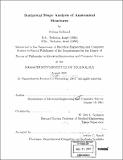Statistical shape analysis of anatomical structures
Author(s)
Golland, Poilna, 1971-
DownloadFull printable version (14.24Mb)
Other Contributors
Massachusetts Institute of Technology. Department of Electrical Engineering and Computer Science.
Advisor
W. Eric L. Grimson.
Terms of use
Metadata
Show full item recordAbstract
In this thesis, we develop a computational framework for image-based statistical analysis of anatomical shape in different populations. Applications of such analysis include understanding developmental and anatomical aspects of disorders when comparing patients vs. normal controls, studying morphological changes caused by aging, or even differences in normal anatomy, for example, differences between genders. Once a quantitative description of organ shape is extracted from input images, the problem of identifying differences between the two groups can be reduced to one of the classical questions in machine learning, namely constructing a classifier function for assigning new examples to one of the two groups while making as few mistakes as possible. In the traditional classification setting, the resulting classifier is rarely analyzed in terms of the properties of the input data that are captured by the discriminative model. In contrast, interpretation of the statistical model in the original image domain is an important component of morphological analysis. We propose a novel approach to such interpretation that allows medical researchers to argue about the identified shape differences in anatomically meaningful terms of organ development and deformation. For each example in the input space, we derive a discriminative direction that corresponds to the differences between the classes implicitly represented by the classifier function. (cont.) For morphological studies, the discriminative direction can be conveniently represented by a deformation of the original shape, yielding an intuitive description of shape differences for visualization and further analysis. Based on this approach, we present a system for statistical shape analysis using distance transforms for shape representation and the Support Vector Machines learning algorithm for the optimal classifier estimation. We demonstrate it on artificially generated data sets, as well as real medical studies.
Description
Thesis (Ph. D.)--Massachusetts Institute of Technology, Dept. of Electrical Engineering and Computer Science, 2001. Includes bibliographical references (p. 123-130).
Date issued
2001Department
Massachusetts Institute of Technology. Department of Electrical Engineering and Computer SciencePublisher
Massachusetts Institute of Technology
Keywords
Electrical Engineering and Computer Science.